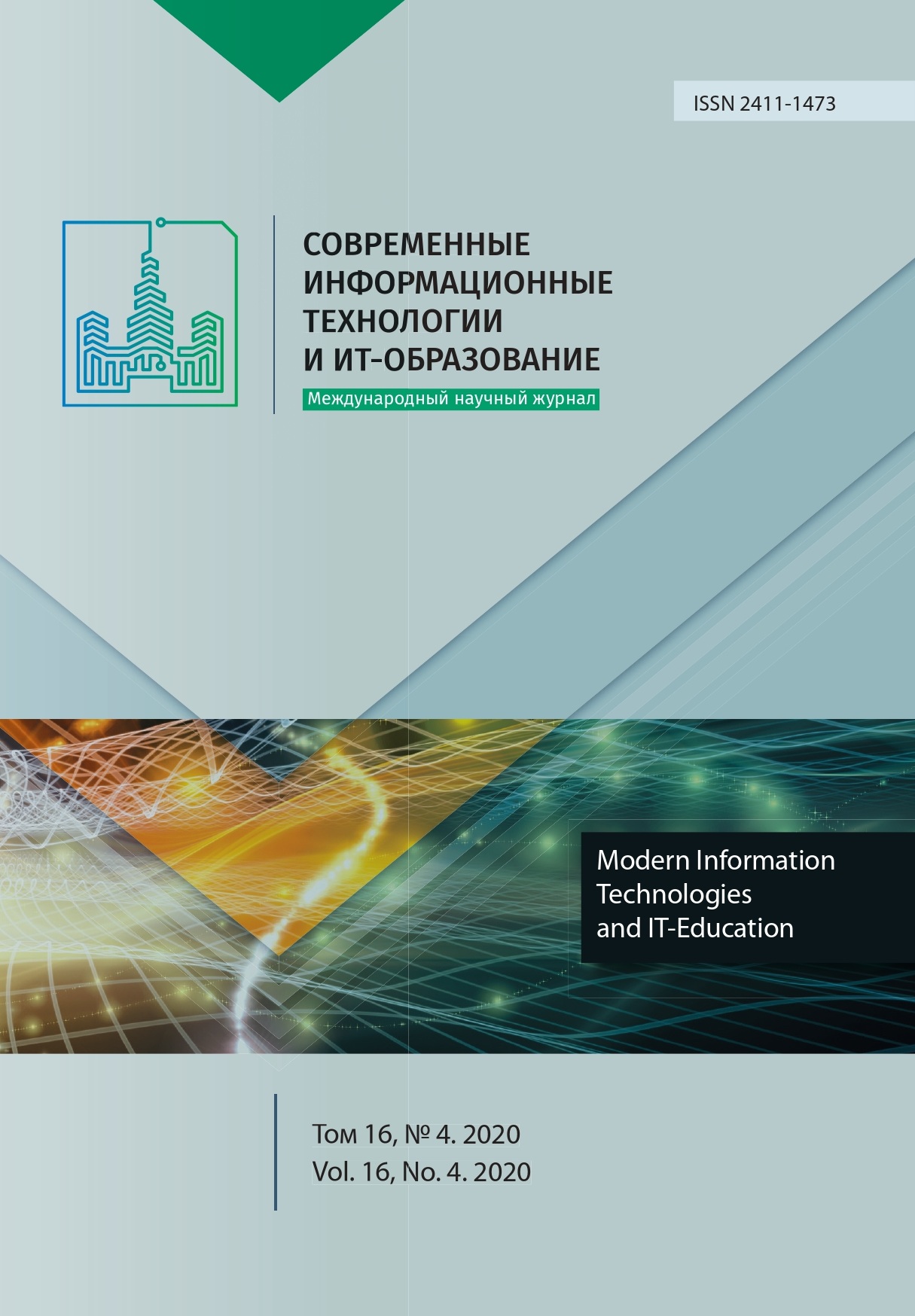Индексирование значений нечеткой переменной
Аннотация
В настоящее время, как в научных работах, так и в программных проектах широко используются нечеткие данные, лингвистические переменные и т.д. Однако в современных СУБД отсутствует поддержка операций над нечеткими данными и средства индексирования этих данных. Предлагается решение задачи индексирования набора нечетких значений лингвистической переменной. Нечеткие переменные представляются в виде замкнутых плоских ломаных или полигонов. Для оптимизации обработки строится проекция полигона, которая будет храниться в иерархическом индексе. Предложена модифицированная структура R-дерева, которая оптимизирована для хранения нечетких значений. Внутренние узлы дерева хранят минимальный ограничивающий интервал для всех дочерних узлов, листовые узлы, кроме того хранят сам полигон нечеткого значения и полигоны соответствующие заданным альфа-уровням. Листовые узлы имеют ссылки на соседние листовые узлы для выполнения операций больше, меньше, неравно. Предложены модифицированные алгоритмы вставки и поиска в модифицированном R-дереве. Проведено тестирование предложенных алгоритмов, которое показало не худшее время выполнения по сравнению со стандартными алгоритмами R-дерева.
Литература
[2]Manolopoulos Y., Nanopoulos A., Papadopoulos A.N., Theodoridis Y. R-Trees: Theory and Applications. Advanced Information and Knowledge Processing. Springer, London; 2006. (In Eng.) DOI: https://doi.org/10.1007/978-1-84628-293-5
[3]Zadeh L.A. The concept of a linguistic variable and its application to approximate reasoning - I. Information Sciences. 1975; 8(3):199-249. (In Eng.) DOI: https://doi.org/10.1016/0020-0255(75)90036-5
[4]Zadeh L.A. Fuzzy sets. Information and Control. 1965; 8(3):338-353. (In Eng.) DOI: https://doi.org/10.1016/S0019-9958(65)90241-X
[5]Klir G.J., Yuan B. Fuzzy Sets and Fuzzy Logic: Theory and Applications. Prentice Hall: Upper Saddle River, NJ; 1995. (In Eng.)
[6]Ryjov A.P. The measure of uncertainty of fuzzy set's collection: Definition, properties and applications. In: 1993 (2nd) International Symposium on Uncertainty Modeling and Analysis. College Park, MD, USA; 1993. p. 51-54. (In Eng.) DOI: https://doi.org/10.1109/ISUMA.1993.366792
[7]Kaufmann A. Introduction to the Theory of Fuzzy Subsets. 1st ed. Academic Pr; 1975. (In Eng.)
[8]Vassilakopoulos M., Corral A., Karanikolas N.N. Join-Queries between Two Spatial Datasets Indexed by a Single R-Tree. In: Černá I. et al. (ed.) SOFSEM 2011: Theory and Practice of Computer Science. SOFSEM 2011. Lecture Notes in Computer Science. 2011; 6543:533-544. Springer, Berlin, Heidelberg. (In Eng.) DOI: https://doi.org/10.1007/978-3-642-18381-2_44
[9]Samet H. The Design and Analysis of Spatial Data Structures. Addison-Wesley Longman Publishing Co., Inc., New York, USA; 1990. (In Eng.)
[10]Copeland R. MongoDB Applied Design Patterns. O’Reilly Media, Sebastopol CA; 2013. (In Eng.)
[11]Wang X. Interval Tree and Its Application in Integer Factorization. Journal of Mathematics Research. 2019; 11(2):103-113. (In Eng.) DOI: http://doi.org/10.5539/jmr.v11n2p103
[12]Allen J.F. Maintaining knowledge about temporal intervals. Communications of the Association for Computing Machinery. 1983; 26(11):832-843. (In Eng.) DOI: https://doi.org/10.1145/182.358434
[13]Trudel A. Interval Algebra Networks with Infinite Intervals. In: 2009 16th International Symposium on Temporal Representation and Reasoning. Bressanone-Brixen, Italy; 2009. p. 141-146. (In Eng.) DOI: https://doi.org/10.1109/TIME.2009.20
[14]Dawood H., Dawood Y. Universal Intervals: Towards a Dependency-Aware Interval Algebra. In: S. Chakraverty (ed.) Mathematical Methods in Interdisciplinary Sciences. Wiley; 2020. p. 167-214. (In Eng.) DOI: https://doi.org/10.1002/9781119585640.ch10
[15]Ligozat G. Qualitative Spatial and Temporal Reasoning. John Wiley & Sons, Inc., London; 2012. (In Eng.)
[16]Bhattacharya A. Fundamentals of Database Indexing and Searching. 1st. ed. Chapman & Hall/CRC, London; 2014. (In Eng.) DOI: https://doi.org/10.1201/b17767
[17]Yang Y., et al. LAZY R-tree: The R-tree with lazy splitting algorithm. Journal of Information Science. 2019; 46(2):243-257. (In Eng.) DOI: https://doi.org/10.1177/0165551519828616
[18]Andreev P.D., Bulygin A.I. On the Vertical Similarly Homogeneous R-Trees. Lobachevskii Journal of Mathematics. 2019; 40(2):127-139. (In Eng.) DOI: https://doi.org/10.1134/S1995080219020033
[19]Srividhya S., Lavanya S.R. Comparative Analysis of R-Tree and R -Tree in Spatial Database. In: 2014 International Conference on Intelligent Computing Applications. Coimbatore, India; 2014. p. 449-453. (In Eng.) DOI: https://doi.org/10.1109/ICICA.2014.98
[20]Nakorn T.N., Chongstitvatana J. The RD-tree Allowing Data in Interior Nodes of the R-tree. In: 2006 IEEE Conference on Cybernetics and Intelligent Systems. Bangkok, Thailand; 2006. p. 1-6. (In Eng.) DOI: https://doi.org/10.1109/ICCIS.2006.252290
[21]Al-Badarneh A.F. Yaseen Q., Hmeidi I. A new enhancement to the R-tree node splitting. Journal of Information Science. 2010; 36(1):3-18. (In Eng.) DOI: https://doi.org/10.1177/0165551509340360
[22]Al-Nsour E., Sleit A., Alshraideh M. SOLD: A node-Splitting algorithm for R-tree based on Objects’ Locations Distribution. Journal of Information Science. 2019; 45(2):169-195. (In Eng.) DOI: https://doi.org/10.1177/0165551518785561
[23]Ang C.H., Tan T.C. New linear node splitting algorithm for R-trees. In: Scholl M., Voisard A. (ed.) Advances in Spatial Databases. SSD 1997. Lecture Notes in Computer Science. 1997; 1262:337-349. Springer, Berlin, Heidelberg. (In Eng.) DOI: https://doi.org/10.1007/3-540-63238-7_38
[24]Vu T., Eldawy A. R-Grove: growing a family of R-trees in the big-data forest. In: Proceedings of the 26th ACM SIGSPATIAL International Conference on Advances in Geographic Information Systems (SIGSPATIAL '18). Association for Computing Machinery, New York, NY, USA; 2018. p. 532-535. (In Eng.) DOI: https://doi.org/10.1145/3274895.3274984
[25]Gaur G., Kalra S., Bhattacharya A. Patterns for Indexing Large Datasets. In: Proceedings of the 23rd European Conference on Pattern Languages of Programs (EuroPLoP '18). Association for Computing Machinery, New York, NY, USA; 2018. Article 5, p. 1-6. (In Eng.) DOI: https://doi.org/10.1145/3282308.3282314

Это произведение доступно по лицензии Creative Commons «Attribution» («Атрибуция») 4.0 Всемирная.
Редакционная политика журнала основывается на традиционных этических принципах российской научной периодики и строится с учетом этических норм работы редакторов и издателей, закрепленных в Кодексе поведения и руководящих принципах наилучшей практики для редактора журнала (Code of Conduct and Best Practice Guidelines for Journal Editors) и Кодексе поведения для издателя журнала (Code of Conduct for Journal Publishers), разработанных Комитетом по публикационной этике - Committee on Publication Ethics (COPE). В процессе издательской деятельности редколлегия журнала руководствуется международными правилами охраны авторского права, нормами действующего законодательства РФ, международными издательскими стандартами и обязательной ссылке на первоисточник.
Журнал позволяет авторам сохранять авторское право без ограничений. Журнал позволяет авторам сохранить права на публикацию без ограничений.
Издательская политика в области авторского права и архивирования определяются «зеленым цветом» в базе данных SHERPA/RoMEO.
Все статьи распространяются на условиях лицензии Creative Commons «Attribution» («Атрибуция») 4.0 Всемирная, которая позволяет другим использовать, распространять, дополнять эту работу с обязательной ссылкой на оригинальную работу и публикацию в этом журналe.













